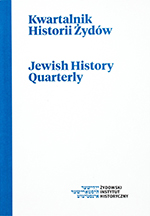Myths of the Orient, Zionism and Israel in the Painting of Adolf Berman (1876-1943)
Myths of the Orient, Zionism and Israel in the Painting of Adolf Berman (1876-1943)
Author(s): Magdalena TarnowskaSubject(s): Cultural history
Published by: Żydowski Instytut Historyczny
Keywords: Adolf Berman; Palestine; Bezalel Academy of Art and Design; Jerusalem; Zionist iconography; Jewish painting; Oriental painting
Summary/Abstract: Adolf Berman (Behrman) was an artist active in Łódź, who became famous for his paintings made during a trip to Africa (before 1911) and the Near East. In Palestine, where he stayed in 1924-1929, he taught art at the Bezalel Academy of Art and Design in Jerusalem. Meanwhile, he created 270 paintings. He lived in Morocco in the years 1932-1935. Some of his works are in the collections of the Jewish History Institute, Historical Museum in Kraków and other European and Israeli collections. Recently his paintings have been showing up in auction houses in Poland. Berman was a representative of the generation of Jewish artists who started their career at the beginning of 20th century. While demonstrating a strong attachment to the Polish culture, they at the same time valued their origins and were active supporters of the idea of the rebirth of Israel as an independent country; still, Berman's own outlook on Zionism remains unknown due to lack of appropriate sources. Palestine was to him a special place, where, as he claimed, you could “develop undisturbed”. He also took part in an exhibition of Jewish art organised by the 'Tel Aviv' publicity in 1921, and in the “Bezalel” exhibition in New York, in 1926. He remained under a strong influence of Zygmunt Bromberg-Bytkowski, a Zionist activist and an art critic, editor of the “Tel Aviv” magazine and the president of Musical and Literary Society “Hazomir”. Zionist ideas were salient in Behrman's work, but it was the Orient that was the true object of his fascination. He painted mystical desert landscapes, Arabian towns, and genre scenes. He even created a Self-portrait in Arabic Attire. His paintings, which carry Zionist symbolism, such as Zaharias' Tomb, Absalom's Tomb, The Western Wall, or historical paintings of Israel, clearly bear an imprint of the Romantic vision of the East. In his unique art, Berman somehow managed to achieve the impossible: combine Orientalism with Zionist ideas.
Journal: Kwartalnik Historii Żydów
- Issue Year: 253/2015
- Issue No: 01
- Page Range: 110-122
- Page Count: 13
- Language: English

